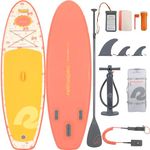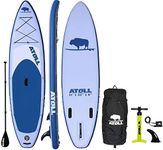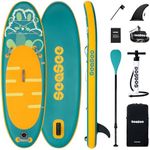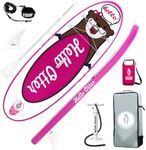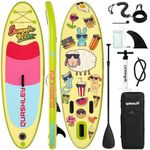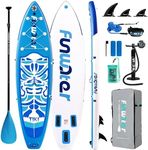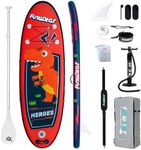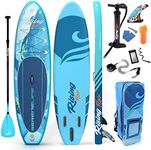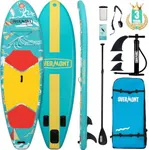Buying Guide for the Best Paddleboard For Kids
Choosing the right paddleboard for kids involves considering several factors to ensure safety, ease of use, and enjoyment. Kids have different needs compared to adults, so it's important to focus on features that cater to their size, strength, and skill level. Here are some key specifications to consider when selecting a paddleboard for kids and how to navigate them.Size and VolumeSize and volume are crucial because they determine the stability and buoyancy of the paddleboard. For kids, a smaller board (typically between 7 to 9 feet in length) is easier to handle and maneuver. The volume, measured in liters, should be enough to support the child's weight without sinking. Generally, a board with a volume of 100-150 liters is suitable for most kids. Choose a size and volume that matches your child's weight and height to ensure they can paddle comfortably and confidently.
WeightThe weight of the paddleboard is important for ease of transport and handling. Kids need a lightweight board that they can carry to and from the water without assistance. Boards made from materials like inflatable PVC or lightweight foam are ideal. Look for boards that weigh between 10 to 20 pounds, as these are manageable for most children.
MaterialThe material of the paddleboard affects its durability and performance. Inflatable boards made from high-quality PVC are great for kids because they are lightweight, easy to store, and resistant to dings and scratches. Hard boards made from foam or fiberglass are also options, but they can be heavier and more prone to damage. Choose a material that balances durability with ease of use for your child.
WidthWidth impacts the stability of the paddleboard. A wider board (around 28 to 32 inches) provides more stability, which is beneficial for beginners and younger kids who are still developing their balance. However, too wide a board can be harder to paddle. Aim for a width that offers a stable platform without compromising the ability to paddle efficiently.
Deck PadThe deck pad is the surface where the rider stands, and it should provide good traction to prevent slipping. Look for a paddleboard with a soft, non-slip deck pad that covers a large area of the board. This is especially important for kids, as it helps them maintain their footing and reduces the risk of falls.
FinsFins help with tracking and stability in the water. For kids, a simple fin setup with one large center fin or three smaller fins (a 2+1 setup) is usually sufficient. These configurations provide good stability and are easy to manage. Ensure the fins are durable and securely attached to avoid any issues during use.
Safety FeaturesSafety is paramount when choosing a paddleboard for kids. Look for boards with safety features such as a leash attachment point, which allows you to attach a leash to keep the board close if they fall off. Additionally, consider boards with rounded edges and soft materials to minimize the risk of injury. Always ensure your child wears a life jacket while paddleboarding.
